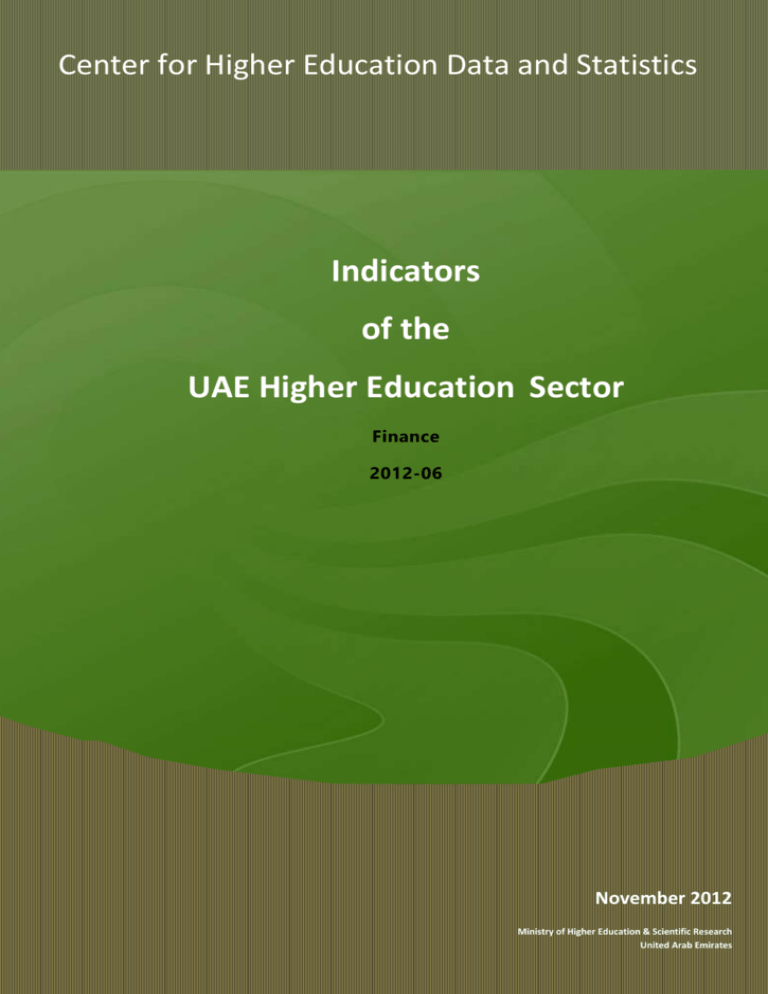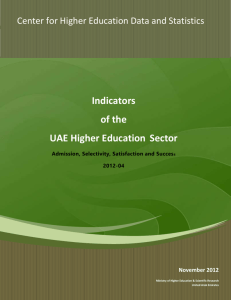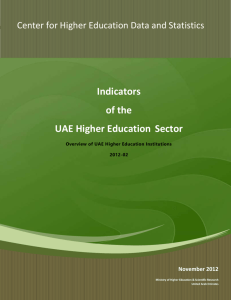Report 2012-06 Finance
advertisement

Center for Higher Education Data and Statistics Indicators of the UAE Higher Education Sector Finance 2012-06 Ministry of Higher Education & Scientific Research United Arab Emirates November 2012 Ministry of Higher Education and Scientific Research Ministry of Higher Education & Scientific Research United Arab Emirates United Arab Emirates Indicators of the UAE HE Sector © Center for Higher Education Data and Statistics 1 Indicators of the UAE HE Sector CENTER FOR HIGHER EDUCATION DATA AND STATISTICS (CHEDS) INDICATORS OF THE UAE HIGHER EDUCATION SECTOR 2012 © Center for Higher Education Data and Statistics 2 Indicators of the UAE HE Sector CHEDS Publication 2012: 06 What is CHEDS? The Center for Higher Education Data and Statistics (CHEDS), located within the Commission for Academic Accreditation in the Ministry of Higher Education and Scientific Research, is the national body for the collection, analysis and reporting of data on higher education in the UAE. © 2012 Center for Higher Education Data and Statistics Ministry of Higher Education and Scientific Research PO Box 45133 Abu Dhabi United Arab Emirates www.cheds.ae © Center for Higher Education Data and Statistics 3 Indicators of the UAE HE Sector Financial Information on the UAE HE Sector, October 2012 1. Actual revenues and expenditures The three federal institutions, 48 among the 59 operational civil CAA-licensed institutions and 2 other institutions submitted complete or partial financial data which consisted of the partition of the budget of the current year into various types of revenues (tuition fees, donation s, and internal services) and expenditures (teaching, research, services, and administration) and their corresponding actual/real figures for the last academic year 2010 -11. In 2010-11, the total of the submitted actual expenditures is AED6 ,199 million for an enrolment of 93,275 students out of the total 2010 enrolment of 103 ,070 students (Fig. 1). (A few institutions were unable, for various reasons, to submit financial data.) This permitted an estimate of the national average yearly cost per student as AED66,455. On the other hand, the total submitted revenues are AED6,517 million, relating to an enrolment of 92,816 students. This gives an estimate of the national average yearly revenue per student as AED68,322. The annual cost per student is estimated as AED77,883 and AED58,586 for federal and CAA licensed institutions respectively (Fig.2), whereas the yearly revenue per student is estimated as AED75,148 and AED60,976 respectively. Note that the cost per student varies significantly between institutions. The annual cost and revenue per student for some CAA-licensed institutions is significantly higher than the average figures of the federal institutions whereas for others the figures are around only AED35,000. 2. Budgeted revenues and expenditures For the academic year 2011-12, the institutions that submitted financial data budgeted an expenditure amount of AED6,714 million. These budgets show that the institutions expected their expenditures to increase on average by 6.1% for a real increase in enrolment of 6.2%. The increase is 5.1% for federal institutions for an increase of 4.9% in the enrolments. The budgeted increase in the expenditures of the CAA-licensed institutions is 7% for an increase of 6.9 % in the enrolments. © Center for Higher Education Data and Statistics 4 Indicators of the UAE HE Sector Table 1 gives the distribution of the budgeted expenditure of the institutions. It shows that 21 institutions have a relatively small real expenditures budget (less than 20 million dirhams) in 2010-2011, and seven CAA-licensed institutions had a real expenditure budget larger than 200 million dirhams. Institutions with a budget less than 20 million dirhams are mainly narrow specialization focused institutions. T ABLE 1: D ISTRIBUTION OF INSTITUTIONS BASED ON TOTAL EXPENDITURES ( IN MILLION DIRHAMS ) less than 20- 40- 60- 80- 100- 120- 200- 250- 300- 350- 400- 450- 500- 550- 1000- 20 40 60 80 100 120 200 250 300 350 400 450 500 550 1000 1500 Actual 21 12 2 5 0 1 0 3 1 1 1 0 1 1 0 2 Budget 19 10 4 3 3 1 1 1 2 0 1 2 1 1 0 2 The total expenditure is divided into three components, namely teaching, services and administrative and others. The reported financial data of 2010-2011 shows that in the UAE 58% of the expenditures is allocated to salaries of academic and administrative staff. This percentage is 69% and 46% for federal and CAA-licensed institutions respectively. The significant difference may be due to the fact that many CAA institutions offer diploma degrees only and therefore they do not require recruitment of terminal degree holders, while federal institutions hire a very small number of part-time faculty. AED468 million (15%) of the revenues of the CAA-licensed institutions is donated by local governments. 79% and 19% of it are donated by Abu Dhabi and Dubai governments respectively. Most of these amounts represent tuition fees of students. Also, there are some institutions whose budgets are taken in charge by companies. The number of CAA-licensed institutions that are significantly supported financially by local governments or organisations is six. 3. Clusters of Institutions CHEDS has computed indicators for 12 clusters of institutions which were identified using the following clustering criteria across four dimensions: Level of programs offered: (up to Diploma, Bachelor degree, Master Degree, and Doctoral programs) (clusters 1-4) Size of institution: Small (<1,000 students), Medium (1,000 to 3,999 students), and Large (>3999 students) (clusters 5-7) the Federal institutions and the CAA-licensed institutions (clusters 8-9) Location of main campus: Abu Dhabi, Dubai, and Northern Emirates (Clusters 10-12) Some results for these clusters are given in the following sections. © Center for Higher Education Data and Statistics 5 Indicators of the UAE HE Sector 4.Revenue and Expenditure per Student Fig. 3 shows that average of both the revenues and the expenditures per student are highest for smaller institutions. This could be explained by the fact this cluster (Cluster 5) contains relatively new institutions which are in the establishment stage and therefore have small enrolment due to their age, and specialized institutions which are specially funded. Revenues and expenditures of the federal institutions, Abu Dhabi based institutions, and those that offer PhD programs are similar to each other and show the second highest revenues / expenditures per student. The least costly institutions are those that are specialized in Associate Degree / Diploma. © Center for Higher Education Data and Statistics 6 Indicators of the UAE HE Sector Cluster 5 – Small institutions The standard errors of these two indicators (revenue and expenditure) are large. In fact this is the case in every one of the clusters. This is first examined in more detail in the highest expenditure cluster, namely the small institutions (Cluster 5). Fig. 4 shows that the institutions collect in four groups, namely those with a per student figure <=AED20,000; 20,001 to 40,000; 40,001 to 100,000; and >100,000. (Institution names have been omitted.) Omitting the last group, Fig. 4 is re-scaled to show the other three groups (Fig. 5). © Center for Higher Education Data and Statistics 7 Indicators of the UAE HE Sector Cluster 1 – Diploma institutions Fig. 6 gives the distribution of the financial resources per student of Cluster 1 which is composed of the eight institutions offering only Diplomas. It shows two institutions with the minimum resources per student, while one institution is at the other end of the scale. © Center for Higher Education Data and Statistics 8 Indicators of the UAE HE Sector Cluster 2- Bachelor institutions Fig.7 indicates that there are four institutions of Cluster 2 (Bachelor institutions) whose resources are close to AED100,000/student. One institution has, almost four times the overall average expenditure of around AED60,000. © Center for Higher Education Data and Statistics 9 Indicators of the UAE HE Sector Cluster 3 – Master institutions Fig. 8 depicts the distribution of the financial resources of the institutions of Cluster 3 which is composed of the institutions that offer up to Master programs. This cluster includes some of the largest institutions. This cluster includes seven of the institutions whose financial resources per student exceeds or is close to AED100,000. Fig. 9 is a reproduction of Fig. 8, omitting the six institutions with greatest resources. © Center for Higher Education Data and Statistics 10 Indicators of the UAE HE Sector Cluster 4 – Doctoral institutions Fig. 10 illustrates the financial situation of the institutions that offer also PhD programs. This cluster is composed of eight institutions, one having significantly more resources than the others. Fig. 11 is a reproduction of Fig. 10, omitting the two institutions with greatest resources. © Center for Higher Education Data and Statistics 11








